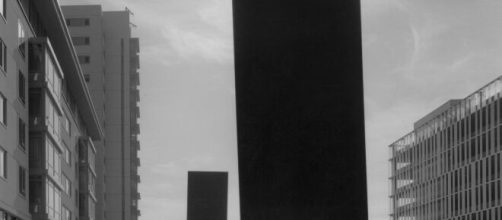On hearing this news, you might imagine Johann Strauss’s waltz “Blue Danube” on the soundtrack for “2001: A Space Odyssey.” Remember? That’s when the voyager enters the docking sequence on planet Jupiter and astronauts find a shiny 12-foot-high slab of steel.
You might think of that ’68 sci-fi film because an equally mystifying, equally tall slab of steel has been discovered by helicopter pilots flying over a remote red rock canyon in Utah. The question that arose in the movie rises again: How did the slab get here?
Mysterious monolith - where’s HAL?
The only thing missing in this scenario is the onboard computer called HAL. Officers from the Department of Public Safety (DPS) could use artificial intelligence to make sense of the baffling discovery. Hyperallergic quoted a helicopter crew member observing that there’s “no obvious indication of who might have put the monolith there.” Pilot Bret Hutchings told KSL 5 News that he thinks a “new-wave artist” placed the monolith there. But none have claimed it. DPS warns that it’s illegal to install anything on federally managed public land without permission.
'This thing is not from another world'
Pilot Hutchings isn’t giving credence to the alien invasion theory.
The Guardian quotes him saying, “We were kind of joking around that if one of us suddenly disappears, then the rest of us make a run for it.”
Despite calling the Utah desert Mars-like and “otherworldly” UK News quotes a staffer of the Utah Highway Patrol - Lt Nick Street - saying quite definitively “This thing is not from another world.”
Is it man-made?
Whoever or whatever did it did it with care. UKNews noted that the slab was well made and carefully embedded in the rock. The Bureau of Land Management is investigating whether it should be removed.
If the steel slab is the work of an artist, Richard Serra, whose sculpture titled Ballast on the UCSF Mission Bay Campus is Utah’s desert slab lookalike.
'Art is not democratic'
At a public hearing, 122 New Yorkers who lived and worked in the area testified, and more than half voted to have the work carted away.
Serra balked at the time, saying he didn’t think it’s the aim of art is to be a people-pleaser. “Art is not democratic,” he said. But the naysayers had their reasons for wanting the work out of sight.
Casting a long shadow
"Tilted Arc", measuring 120-feet long and 12 feet high that sat across the Federal Plaza sidewalk, was viewed as an eyesore, and blocked people’s path. It also was said to create too much shadow. Political scientist Marshall Berman called the work “a shout in the street” in his 1988 book “All that is Solid Melts.”
Is the slab of steel in the Utah Serra’s shout in the desert?


